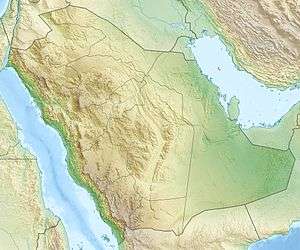Wahhabi War
| Wahhabi War | |||||||
|---|---|---|---|---|---|---|---|
Sites of major battles during the war. | |||||||
| |||||||
| Belligerents | |||||||
|
Al-Qasim | |||||||
| Commanders and leaders | |||||||
|
Shar'an |
| ||||||
| Strength | |||||||
| 20,000 | 50,000 | ||||||
| Casualties and losses | |||||||
|
14,000 dead 6,000 wounded[1] |
2,000 dead 1,000 wounded 50 captured | ||||||
The Wahhabi War was fought from early 1811 to 1818, between Egypt Eyalet under the reign of Muhammad Ali Pasha (nominally under Ottoman rule) and the army of the Emirate of Diriyah, the First Saudi State, resulting in the destruction of the latter.
Background
The Wahhabi movement was a fundamentalist sect within Islam founded by Muhammad ibn Abd-al-Wahhab that would lead to creation of the Emirate of Diriyah as he and Muhammad bin Saud launched their campaign to reform Islam and consolidate power in Arabia from their power-base, and its eventual crushing by the Ottoman Empire’s Egyptian khedive Muhammad Ali of Egypt.
In 1802 12,000 Wahhabis sacked Karbala in Iraq killing up to 5,000 people and plundering the Imam Husayn Shrine.[2] By 1805, the Wahhabis controlled Mecca and Medina.[2] The Wahhabis also attacked Ottoman trade caravans which interrupted the Ottoman finances.[3] The Saudi amir denounced the Ottoman sultan and called into question the validity of his claim to be caliph and guardian of the sanctuaries of the Hejaz[4] and the Ottoman Empire, suspicious of the ambitious Muhammad Ali, instructed him to fight the Wahhabis, as the defeat of either would be beneficial to them.[3] Tensions between Muhammad Ali and his Albanian troops also prompted him to send them to Arabia and fight against the Wahhabi movement where many died.[5]
Campaigns
Muhammad Ali was ordered to crush the Saudi state as early as December 1807 by Sultan Mustafa IV, however internal strife within Egypt prevented him from giving full attention to the Wahhabis. The Albanians were not able to recapture the holy cities until 1811.[4]
in 1817, Ibrahim Pasha, Muhammad Ali’s son, had taken over the campaign, gaining support of the volatile Arabian tribes by skillful diplomacy and lavish gifts, he advanced into central Arabia to occupy the towns of Unaizah and Buraidah. He was then joined by most of the principal tribes and marched to the Saudi capital Diriyah. However, their march to Diriyah was plagued by Wahhabi attacks when they arrived in Diriyah in April 1818. It took until September for the Wahhabis to surrender, in part due to Ibrahim’s poorly trained army. Diriyah was destroyed in June 1819 and Egyptian garrisons were posted in the principal towns.
It was not until September 1818 that the Wahhabi state ended with the surrendering of the its leaders and the head of the Wahhabi state, Abdullah bin Saud, who was sent to Istanbul to be executed.[4]
Aftermath
Most of the political leaders were treated well but the Ottomans were far harsher with the religious leaders that inspired the Wahhabi movement, executing Sulayman ibn Abd Allah and other religious notables, as they were thought to be uncompromising in their beliefs and therefore a much bigger threat than political leaders. The execution of also reflects the Ottoman resentment of the Wahhabist views.[4]
References
- ↑ Vasiliev, Alexei. The History of Saudi Arabia. NYU Press. ISBN 9780814788097. Retrieved 21 February 2017.
- 1 2 Bowen, Wayne H. (2008). The History of Saudi Arabia. Westport, CN: Greenwood Press. p. 153. ISBN 978-0313340123. OCLC 166388162.
- 1 2 Afaf Lutfi al-Sayyid-Marsot. A History of Egypt From the Islamic Conquest to the Present. New York: Cambridge UP, 2007.
- 1 2 3 4 Elizabeth Sirriyeh, Salafies, "Unbelievers and the Problems of Exclusivism". Bulletin (British Society for Middle Eastern Studies), Vol. 16, No. 2. (1989), pp. 123-132. (Text online at JSTOR)
- ↑ Fahmy, Khaled (2012). Mehmed Ali: From Ottoman Governor to Ruler of Egypt. Oneworld Publications. p. 30. ISBN 9781780742113.
